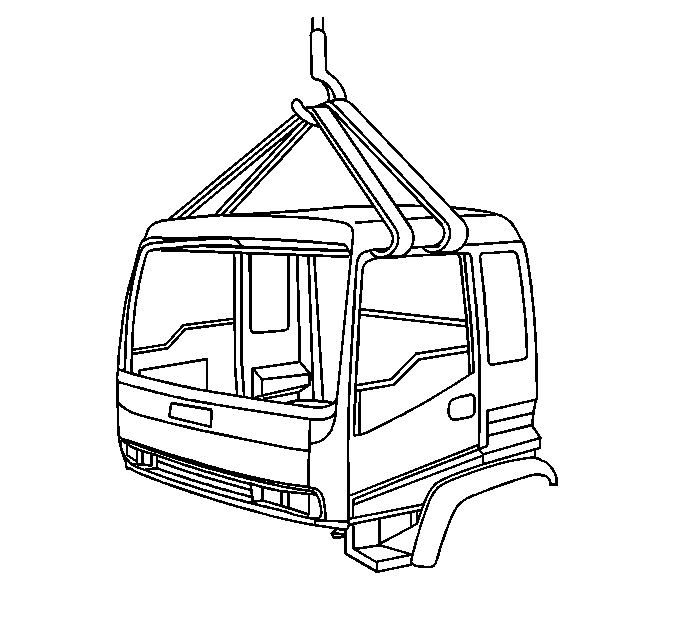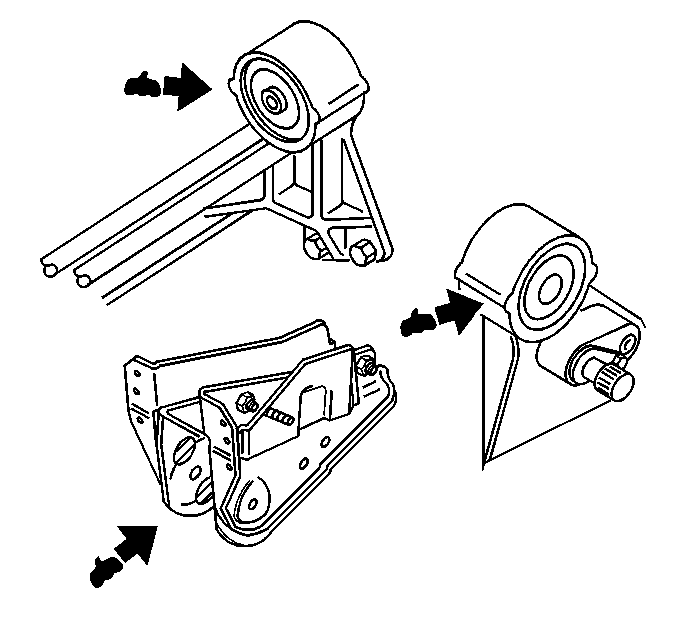Removal Procedure
The cab replacement procedure will vary depending upon the optional equipment on the vehicle. Some steps required, due to optional equipment, have been included. Inspect the vehicle for any special steps which may be required. The following procedures
are intended to be used only as a guide.
- Block the wheels.
- Disconnect the negative battery cable. Refer to
Battery Negative Cable Disconnection and Connection
.
- Open the hood.
Important: Tag all the components, including the following, during removal for proper location during installation:
- Remove the grille. Refer to
Grille Replacement
.
- Remove the left and the right headlamp assemblies. Refer to
Headlamp Replacement
.
- Recover the air conditioning refrigerant. Refer to
Refrigerant Recovery and Recharging
.
- Remove the air conditioning pipes and the brackets. Refer to
Evaporator Inlet Hose Replacement
and
Evaporator Outlet Hose Replacement
.
- Drain the coolant. Refer to
Cooling System Draining and Filling
.
- Remove the heater pipes. Refer to
Heater Inlet Hose Replacement
, and to
Heater Outlet Hose Replacement
.
- Remove the ground strap.
- Remove the main wire harness under the hood.
- Remove the clutch fluid pipe, if equipped.
- Disconnect the transmission control cables. Refer to
Shift Cable Replacement
for the manual transmission or
Shift Cable Replacement
for the automatic transmission.
- Disconnect the parking brake cable. Refer to
Park Brake Cable Replacement
.
- Tilt the cab. Refer to
Cab Tilting
.

- Remove the air brake hoses, if equipped, or the linkage to the brake master cylinder. Refer to the appropriate procedures in Brakes.
- Remove the steering shaft at the steering gear. Mark the shaft and the gear in order to aid in reassembly. Refer to
Lower Steering Shaft Assembly Replacement
.
- Remove the cab lock assembly nuts and bolts.
- Remove the cab lock cover.
- Fasten a rope or strap securely to the cab lock. Use a hoist or chain block in order to keep the cab tilted.
- Remove the torsion bar lever nuts and bolts.
- Remove the torsion bar levers.
- Remove the cab tilt support. Refer to
Cab Tilt Support Replacement
.
- Lower the cab. Refer to
Cab Tilting
.
- Remove each center pin by tapping with a hammer, while lowering the cab slowly.

Notice: When the cab is being removed, ensure that the lifting straps are not
wrapped around the door frames. Otherwise, damage to the window
channels may occur.
- The trimmed cab weighs about 500 kg (1,340 lb).
| 26.1. | Use 4 commercial straps that are 152 mm (6 in) wide and about 3 m (10 ft) long in order to lift the cab from the chassis. |
| 26.2. | Open the doors. Pass the straps into the cab through the door opening on each side through the rear of the cab. |
| 26.3. | Connect the straps in the center. |
- Walk around the cab in order to make sure all components have been disconnected from the chassis.
- Raise the cab slowly. Use the aid of a helper in order to guide the cab while the cab is being lifted.
Installation Procedure

- Block the chassis wheels.
Notice: When the cab is being removed, ensure that the lifting straps are not
wrapped around the door frames. Otherwise, damage to the window
channels may occur.
- The trimmed cab weighs about 500 kg (1,340 lb).
| 2.1. | Use 4 commercial straps that are 152 mm (6 in) wide and about 3 m (10 ft) long in order to lift the cab from the chassis. |
| 2.2. | Open the doors. Pass the straps into the cab through the door opening on each side through the rear of the cab. |
| 2.3. | Connect the straps in the center. |

- Apply grease to the following areas of the cab mounts:
| • | The circumference area of the bracket where the washer comes in contact |
| • | The bushing inner surface in the side where the sleeve is inserted |
| • | At least 2 areas on both inside surfaces of the bracket where the washer comes in contact |

- Install the left center pin and the right center pin.
- Perform the following procedure:
| 5.1. | Hook a wire to the cab striker. |
| 5.2. | Pull the safety lever. |
| 5.3. | Tilt the cab slowly. |
| 5.4. | Use the wire in order to keep the cab from floating up. |
- Extend the cab tilt support and lock it into position.
Notice: Use the correct fastener in the correct location. Replacement fasteners
must be the correct part number for that application. Fasteners requiring
replacement or fasteners requiring the use of thread locking compound or sealant
are identified in the service procedure. Do not use paints, lubricants, or
corrosion inhibitors on fasteners or fastener joint surfaces unless specified.
These coatings affect fastener torque and joint clamping force and may damage
the fastener. Use the correct tightening sequence and specifications when
installing fasteners in order to avoid damage to parts and systems.
- Install the cab support nuts and bolts.
Tighten
Tighten the nuts and bolts to 68 N·m (50 lb ft).
- Perform the following procedure in order to install the torsion bar levers:
| 8.1. | Locate the left and right identification marks before installation. |
| 8.3. | Install the torsion bar levers. |
| 8.4. | Install the torsion bar lever nuts and bolts. |
Tighten
Tighten the bolts and nuts to 37 N·m (27 lb ft).
- Use the match marks made during disassembly as a guide in order to apply grease to the steering shaft. Refer to
Fluid and Lubricant Recommendations
.
- Insert the steering shaft on the steering unit. Refer to
Lower Steering Shaft Assembly Replacement
.
- Tighten the steering shaft bolt.
Tighten
Tighten the bolts to 61 N·m (45 lb ft).
- Connect the throttle cable.
- Connect the transmission cables. Refer to
Shift Cable Replacement
for the manual transmission or
Shift Cable Replacement
for the automatic transmission.
- Connect the air brake hoses, if equipped, or the linkage to the brake master cylinder.
- Connect the parking brake cable. Refer to
Park Brake Cable Replacement
.
- Lower the cab. Refer to
Cab Tilting
.
- Install the clutch fluid pipe, if equipped.
- Install the main wire harness under the hood.
- Install the ground strap.
- Install the heater pipes. Refer to the
Heater Inlet Hose Replacement
or to
Heater Outlet Hose Replacement
.
- Install the air conditioning pipes and the brackets. Refer to
Evaporator Inlet Hose Replacement
and
Evaporator Outlet Hose Replacement
.
- Install the left and the right headlamp assemblies. Refer to
Headlamp Replacement
.
- Install the grille. Refer to
Grille Replacement
.
- Connect the negative battery cable. Refer to
Battery Negative Cable Disconnection and Connection
.
- Recharge the air conditioning refrigerant to specification. Refer to
Refrigerant Recovery and Recharging
.
- Refill the engine coolant to proper level. Refer to
Fluid and Lubricant Recommendations
.
- Bleed the clutch system. Refer to
Hydraulic Clutch Bleeding
.





